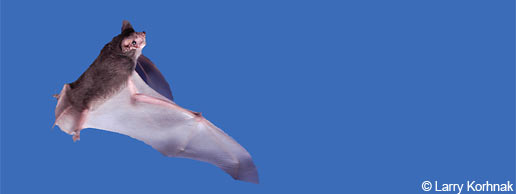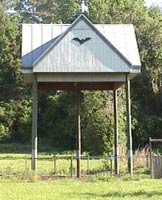
The Bats of the University of Florida Bat House
The Brazilian Free-Tailed Bat (Tadarida brasiliensis) and the Southeastern Bat (Myotis austroriparius)

by Bill Kern
The Brazilian Free-tailed Bat is in the Family Molossidae. These bats are called "free-tailed" because the end of the tail extends beyond the edge of the tail membrane, looking like a mouse's tail. All of the other bats of Florida, including the Southeastern Bat, are in the family Vespertilionidae and the tail membrane goes to the tip of the tail. The Brazilian free-tailed bat is one of the most abundant native mammals living in urban areas in Florida. It occurs statewide. They form colonies (from 50-20,000 bats) in man-made structures like buildings and under bridges. Free-tails are a medium sized bat (7-14 g) with brownish gray fur. Free-tails have a distinctive musky odor. It is often possible to smell a large colony of Free-tailed bats from a long distance away, up to half a block if the wind is right. Free-tailed bats are strong fast fliers with long narrow wings. They can fly at more than 25 mph and are known to fly to an altitude over 9,000 feet.
The subspecies found in Florida and the southeastern United States is called Tadarida brasiliensis cynocephala (cynocephala = dog head). The bat that occurs in colonies by the millions in Carlsbad Cavern in New Mexico and Bracken Cave in Texas is the Mexican Free-tailed Bat (Tadarida brasiliensis mexicana). This subspecies occurs in the western United States and Mexico. Our southeastern free-tailed bat differs in two very important ways from the Mexican subspecies: Our free-tailed bats do not migrate and are never found in caves. The Mexican free-tailed bat migrates in to Mexico in the Fall and returns north in the Spring and is one of the most abundant species inn caves.
The free-tailed bat in Florida commonly roosts under the tiles of Spanish tile roofs, inside concrete block walls, in attics, behind facia boards, in chimneys, and in the expansion joints of concrete structures like bridges and stadiums. They often share these structures with evening bats (Nycticeius humeralis), southeastern bats (Myotis austroriparius), and big brown bats (Eptesicus fuscus). Free tails sometimes roost in different structures in the winter than they use for maternity colonies in the summer, but they now occupy this bat house year-round. Free-tails mate from mid-February through late March. After an eleven to twelve week gestation period, the female gives birth to a single pup in the end of May or the first week of June depending on the Spring temperatures. The pups stay in the roost while their mothers go out to feed. They group together to keep warm and for mutual comfort. This group of huddling young is called a creche (pronounced kresh). The young start flying about 5 weeks after their birth and then fly with their mothers for several weeks before venturing out on their own. In August and September, the number of solitary young bats that show up in or on buildings is due to those juveniles being of on their own and getting lost.
The Southeastern bat is a small bat (6-10 g) with woolly brown fur. The scientific name means "mouse-eared bat of southern streams". This bat primarily winters and has its maternity colonies in caves, but will also roost in storm drains, bridges, buildings and bat houses. There are about 100 southeastern bats that share this bat house with the free-tailed bats. These bats are unusual in that they usually have twins rather than a single pup. These bats give birth in early May. The southeastern bat has broad wings for slow acrobatic flight and these are the bats seen flying slowly over the fields before the masses of free-tails emerge. They feed on small soft bodied insects like midges, moths, mayflies, planthoppers, and small beetles.
People often ask "What good are bats?" All of the bats that live in Florida and almost all of the bats in the United States are insect eaters. They are the primary predator of night-flying insects. As an example, this bat house was constructed on the University of Florida campus in Gainesville in 1991 and now houses over 100,000 bats. Each night the free-tailed bats in this one colony eat about 10-20 million insects, assuming that each bat consumes 500-1000 of the small insects this species prefers. If we make the conservative assumption that each bat eats half its body weight in insects a night, then that's 220 pounds of leafhoppers, moths, midges, winged ants, beetles, and other night-flying insects removed from our yards, gardens, and farms every night. Nursing mothers are known to eat up to 125% of their body weight in insects each night. These bats are living in a structure created specifically for them by the University of Florida and the University Athletic Association and now provide free pest control for the university and Gainesville. This is the largest occupied "bat house" in North America and perhaps the world.


 Location: http://yourdomain.edu
Location: http://yourdomain.edu